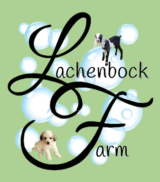Great Pyrenees
Breed History And Facts
Great Pyrenees (GP’s) are one of the oldest livestock guardian dog breeds around. Fossils of Pyrenees have been dated back as far as 1800BC. They’ve been selectively bred for a very, very, long time to not only be protectors but also caretakers of livestock. They will lay their life down without hesitation to protect a member of their flock. I’ve also watched them cuddle and play with young stock and gently nudge ill or injured livestock. We use them to protect our herd of goats from the large packs of coyotes that inhabit the mountains we call home. We breed them because we believe they’re the best breed of LGD (livestock Guardian Dog) on the planet!! If you’re considering investing in a Great Pyrenees, whether it be as an LGD or a pet (yes they make great pets too) there’s certain things you should know about them.
First, Great Pyrenees are not like most other breeds. They’ve been bred to be independant thinkers which makes them much less human needy. This independant thinking enables them to discern friend from foe, which is why they often initially exhibit apprehension and pensiveness towards people and situations they’re unfamiliar with….they’re taking the time to assess the situation. This is the result of being trusted for months on end to watch over their flocks in the Pyrenees Mountains with little to no human contact. The downside to being an independent thinker is their general unwillingness to participate in things like obedience or agility training, playing fetch etc… to the independant thinking Pyrenees those things make absolutely no sense. “Why retrieve that ball, you’ll only throw it again?”. “Why run between all those poles when I can simply meander around them?”, “Sit/Stay? Who me? Maybe later, I’m on duty right now”.
GP’s are double coated dogs. This double coat enables them to not only withstand cold that would cause human toes to freeze and fall off, but they actually prefer cold weather. I’ve watched our dogs lay in the snow and actually pant, cold weather doesn’t phase a GP. Heat is another story. Summer heat can be difficult for Pyrenees. Always provide a shelter or shade with lots of fresh water. Pyrenees will often dig holes or dens to lay in during the day to keep cool. Clipping a pyrenees during the summer is a heated (no pun intended) topic of debate among Pyrenees breeders. Some feel the double coat enables the dogs to retain and circulate cooler air next to the skin, others believe clipping allows them to expel body heat to keep them cooler. We choose neutraility on this topic. Some dogs we’ve clipped, others we’ve left with long coats. I’ve noticed little difference either way.
If you choose to have your Pyrenees clipped, please leave the fur at least 1 inch long to protect from sunburn, their leopard patterned skin is very sensitive. Also never shave your Pyrenees to the skin unless absolutely necessary. Shaving affects the hair follicles and can lead to bald patches or very slow fur regrowth. We had to have one of Pyrenees partially shaved due to injury, it took over 2 years to grow the fur back. While we’re on the topic of fur, if you choose to have a Pyrenees as an indoor pet, a good vaccum cleaner is a must!! These dogs give new meaning to the word “shedding”.
Other important things to know about Pyrenees is they’re nocturnal by nature because that’s when the predators are out hunting for food. If keeping one as an indoor pet, they will easily adjust to your schedule. We have one as an indoor pet, she sleeps quietly next to the bed every night, not a peep out of her. However if kept outdoors or on pasture as an LGD, they can be a bit noisy at times since barking is their first line of defense. It’s how they let the predators know they’re on duty.
Also, if kept as a pet, good fencing is required. Pyrenees see themselves as the caretaker of their kingdom. The only problem is their kingdom tends to be as far as the eye can see. No amount of boundary training will keep a Pyrenees from wondering, trust me when I say they can roam several miles at a time. A 4ft fence is necessary to contain them.
For those looking for a guardian for livestock, there’s some people that will tell you to put the puppy out with livestock, have little contact or ignore the puppy completely to help it bond better with livestock. This is flawed thinking, we do not subscribe to this philosophy or recommend it. This flawed logic is the main reason Great Pyrenees wind up in animal shelters. All pups need training and guidance, LGD’s are no different, especially puppies. They’ll make mistakes. They’ll chew, chase, bite, and do all the things any other puppy would do. They require an investment of time, they’ll need correction as well as praise. A well trained LGD that can be trusted witl livestock is worth it’s weight in gold. If you’re not willing to make the investment of time then please find a different form of livestock protection or purchase an adult dog already trained.
If you’re interested in sharing your home or your farm with one of our Pyrenees, feel free to contact us with any questions you may have. [contact-form to=’[email protected]’ subject=’Great Pyrenees Inquiry’ jetpackCRM=’1′][contact-field label=’Name’ type=’name’ required=’1′ requiredtext='(required)’/][contact-field label=’Email’ type=’email’ required=’1′ requiredtext='(required)’/][contact-field label=’Website’ type=’url’ requiredtext='(required)’/][contact-field label=’Message’ type=’textarea’ requiredtext='(required)’/][/contact-form]
